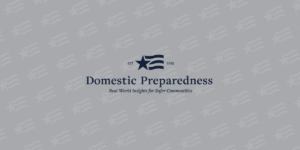
Creating a Common Operating Picture for Wildfire Season
Akshay Birla
July 27, 2022
Life is beginning to return to normal following the past two years of the pandemic, but the world is still as unpredictable as ever. When it seems as though one

Societal Violence & Its Impact on Critical Infrastructure
Nathan DiPillo and Tim Scarrott
July 27, 2022
The “new normal” following the COVID-19 outbreak is still evolving. Although some people have welcomed the relief from many years of commuting and focused on personal growth and time with

HHS Strengthens Country’s Preparedness for Health Emergencies, Announces Administration for Strategic Preparedness and Response (ASPR)
Domestic Preparedness
July 27, 2022
The U.S. Department of Health and Human Services (HHS) announced that Secretary Xavier Becerra has elevated the existing Office of the Assistant Secretary for Preparedness and Response (ASPR) from a staff division to an operating division, taking on the new name of the Administration for Strategic Preparedness and Response (ASPR). This change will allow ASPR to mobilize a coordinated national response more effectively and efficiently during future disasters and emergencies in close collaboration with its sister agencies.

DHS Establishes New Office of Health Security
Domestic Preparedness
July 27, 2022
The U.S. Department of Homeland Security (DHS) established the Office of Health Security, a new office that will serve as the principal medical, workforce health and safety, and public health authority for DHS.

Discovering Another New Normal
Catherine L. Feinman
July 27, 2022
Because of the interconnectedness of so many aspects of society, the authors in this July edition
of the Domestic Preparedness Journal help readers better understand what is needed in the new normal: a
common operating picture, predictable lifelines, new or repurposed technological tools, and more. The
new normal after COVID will be quite different from the years after 9/11. However, with critical
thinking, research, and innovation, communities will discover their new normal – again.

Four Takeaways From the Nashville Christmas Bombing
Robert F. Kelly and Dean C. Alexander
July 20, 2022
The Nashville Christmas bombing provides valuable lessons about targeted violence incidents. This research on pre-attack indicators shares four key takeaways for law enforcement and other preparedness professionals to understand regarding lone wolf and leaderless resistance attacks. Knowing other pre-attack indicators may help thwart a future attack even when the motive is unknown.

Teleforensic Tools – From Telemedicine to Law Enforcement
Michael Melton
July 20, 2022
Telemedicine capabilities have become valuable medical tools to provide life-saving treatment to patients where and when needed. Similarly, off-site skills and knowledge can be transferred to on-site law enforcement personnel through teleforensics to identify and thwart threats, while increasing crime clearances. This article describes how expanding capabilities, identifying needs, delivering instructions, and facilitating remote applications are examples of technology serving as a force multiplier across disciplines.

FEMA, AARP Release New Resources to Help Local Communities Protect Older Adults Before, During and After Natural Disasters
Domestic Preparedness
July 18, 2022
Federal Emergency Management Agency (FEMA) and American Association of Retired Persons (AARP) have released new resources to help local officials and emergency managers protect older adults in their communities before, during and after natural disasters and support communities in mitigating the effects of extreme weather events.

Review of the December 2021 Log4j Event
Domestic Preparedness
July 18, 2022
The scale and efficiency of our global technology infrastructure are made possible through the standardization of key building blocks. These reusable building blocks, while useful for creating software at scale

Guide to Expanding Mitigation: Making the Connection to Older Adults
Domestic Preparedness
July 18, 2022
This Guide to Expanding Mitigation for Older Adults was created in partnership between FEMA and AARP, the nation’s largest advocacy organization representing the needs of Americans age 50 and older.






